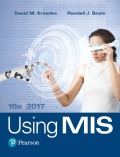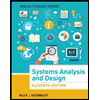
EBK USING MIS
10th Edition
ISBN: 8220103633642
Author: KROENKE
Publisher: YUZU
expand_more
expand_more
format_list_bulleted
Textbook Question
Chapter 1.7, Problem 4ARQ
How can you use the five-component model?
Name and define each of the five components. Explain the symmetry in the five-component model. Show how automation moves work from one side of the five-component structure to the other. Name the most important component and state why it is the most important. Use the five-component model to describe the differences between high-tech and low-tech information systems. Explain how the components are ordered according to difficulty of change and disruption.
Expert Solution & Answer
Want to see the full answer?
Check out a sample textbook solution
Students have asked these similar questions
4. |z + 5 - 5i| = 7
14.
dz,
C: |z❘
C: |z❘ = 0.6
ze² - 2iz
H
14.
dz,
C: |z❘
C: |z❘ = 0.6
ze² - 2iz
H
Chapter 1 Solutions
EBK USING MIS
Ch. 1.4 - Prob. 1AAQCh. 1.4 - Prob. 2AAQCh. 1.4 - Prob. 3AAQCh. 1.4 - Prob. 4AAQCh. 1.7 - Prob. 1EGDQCh. 1.7 - Prob. 2EGDQCh. 1.7 - Prob. 3EGDQCh. 1.7 - Prob. 4EGDQCh. 1.7 - Prob. 5EGDQCh. 1.7 - Prob. 6EGDQ
Ch. 1.7 - Prob. 7EGDQCh. 1.7 - Prob. 8EGDQCh. 1.7 - Prob. 1SGDQCh. 1.7 - Prob. 2SGDQCh. 1.7 - Prob. 3SGDQCh. 1.7 - Prob. 4SGDQCh. 1.7 - Prob. 5SGDQCh. 1.7 - Prob. 1CGDQCh. 1.7 - Prob. 2CGDQCh. 1.7 - Prob. 3CGDQCh. 1.7 - Prob. 4CGDQCh. 1.7 - Prob. 1ARQCh. 1.7 - Prob. 2ARQCh. 1.7 - Prob. 3ARQCh. 1.7 - How can you use the five-component model? Name and...Ch. 1.7 - Prob. 5ARQCh. 1.7 - Prob. 6ARQCh. 1.7 - Prob. 7ARQCh. 1 - Prob. 1.1UYKCh. 1 - Prob. 1.2UYKCh. 1 - Prob. 1.3UYKCh. 1 - Prob. 1.4CE1Ch. 1 - Prob. 1.5CE1Ch. 1 - Prob. 1.6CE1Ch. 1 - Prob. 1.7CE1Ch. 1 - Prob. 1.8CE1Ch. 1 - Prob. 1.9CS1Ch. 1 - Prob. 1.1CS1Ch. 1 - Prob. 1.11CS1Ch. 1 - Prob. 1.12CS1Ch. 1 - Prob. 1.13CS1Ch. 1 - Prob. 1.14CS1Ch. 1 - Prob. 1.15MML
Knowledge Booster
Learn more about
Need a deep-dive on the concept behind this application? Look no further. Learn more about this topic, computer-science and related others by exploring similar questions and additional content below.Similar questions
arrow_back_ios
SEE MORE QUESTIONS
arrow_forward_ios
Recommended textbooks for you
 Fundamentals of Information SystemsComputer ScienceISBN:9781337097536Author:Ralph Stair, George ReynoldsPublisher:Cengage Learning
Fundamentals of Information SystemsComputer ScienceISBN:9781337097536Author:Ralph Stair, George ReynoldsPublisher:Cengage Learning Systems ArchitectureComputer ScienceISBN:9781305080195Author:Stephen D. BurdPublisher:Cengage Learning
Systems ArchitectureComputer ScienceISBN:9781305080195Author:Stephen D. BurdPublisher:Cengage Learning Principles of Information Systems (MindTap Course...Computer ScienceISBN:9781305971776Author:Ralph Stair, George ReynoldsPublisher:Cengage Learning
Principles of Information Systems (MindTap Course...Computer ScienceISBN:9781305971776Author:Ralph Stair, George ReynoldsPublisher:Cengage Learning Principles of Information Systems (MindTap Course...Computer ScienceISBN:9781285867168Author:Ralph Stair, George ReynoldsPublisher:Cengage Learning
Principles of Information Systems (MindTap Course...Computer ScienceISBN:9781285867168Author:Ralph Stair, George ReynoldsPublisher:Cengage Learning Systems Analysis and Design (Shelly Cashman Serie...Computer ScienceISBN:9781305494602Author:Scott Tilley, Harry J. RosenblattPublisher:Cengage Learning
Systems Analysis and Design (Shelly Cashman Serie...Computer ScienceISBN:9781305494602Author:Scott Tilley, Harry J. RosenblattPublisher:Cengage Learning

Fundamentals of Information Systems
Computer Science
ISBN:9781337097536
Author:Ralph Stair, George Reynolds
Publisher:Cengage Learning

Systems Architecture
Computer Science
ISBN:9781305080195
Author:Stephen D. Burd
Publisher:Cengage Learning


Principles of Information Systems (MindTap Course...
Computer Science
ISBN:9781305971776
Author:Ralph Stair, George Reynolds
Publisher:Cengage Learning

Principles of Information Systems (MindTap Course...
Computer Science
ISBN:9781285867168
Author:Ralph Stair, George Reynolds
Publisher:Cengage Learning

Systems Analysis and Design (Shelly Cashman Serie...
Computer Science
ISBN:9781305494602
Author:Scott Tilley, Harry J. Rosenblatt
Publisher:Cengage Learning
9.1.2 Software Development Approaches; Author: EIToppo;https://www.youtube.com/watch?v=Z9znuSQ7Sz8;License: Standard YouTube License, CC-BY